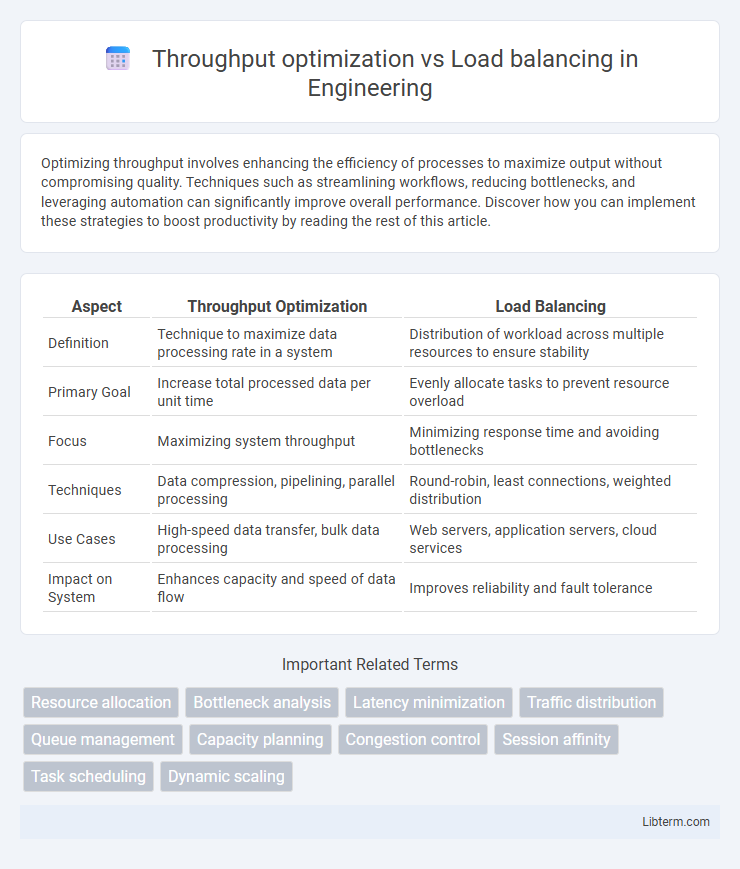Optimizing throughput involves enhancing the efficiency of processes to maximize output without compromising quality. Techniques such as streamlining workflows, reducing bottlenecks, and leveraging automation can significantly improve overall performance. Discover how you can implement these strategies to boost productivity by reading the rest of this article.
Table of Comparison
| Aspect | Throughput Optimization | Load Balancing |
|---|---|---|
| Definition | Technique to maximize data processing rate in a system | Distribution of workload across multiple resources to ensure stability |
| Primary Goal | Increase total processed data per unit time | Evenly allocate tasks to prevent resource overload |
| Focus | Maximizing system throughput | Minimizing response time and avoiding bottlenecks |
| Techniques | Data compression, pipelining, parallel processing | Round-robin, least connections, weighted distribution |
| Use Cases | High-speed data transfer, bulk data processing | Web servers, application servers, cloud services |
| Impact on System | Enhances capacity and speed of data flow | Improves reliability and fault tolerance |
Understanding Throughput Optimization
Throughput optimization enhances data processing efficiency by maximizing the amount of work completed in a given time frame, often measured in transactions per second or data bits per second. It involves techniques such as resource allocation, minimizing bottlenecks, and efficient packet scheduling to ensure optimal system performance. Unlike load balancing, which distributes workload to prevent overload, throughput optimization directly targets increasing the total output capacity of a network or system.
What is Load Balancing?
Load balancing is the process of distributing network or application traffic across multiple servers to ensure no single server becomes overwhelmed, thereby improving system reliability and responsiveness. It optimizes resource use, maximizes throughput, minimizes response time, and avoids overload on any single server. By dynamically allocating workloads, load balancing enhances overall performance and enables scalable, efficient handling of client requests.
Key Differences: Throughput Optimization vs Load Balancing
Throughput optimization focuses on maximizing the amount of data processed over a network or system within a given time frame, enhancing overall efficiency and performance. Load balancing distributes network traffic or computational tasks across multiple servers or resources to prevent any single component from becoming a bottleneck, improving reliability and response times. The key difference lies in throughput optimization aiming to increase data transfer rates, while load balancing emphasizes even workload distribution to maintain system stability.
Core Principles of Throughput Optimization
Throughput optimization focuses on maximizing data processing efficiency by identifying and eliminating bottlenecks in system workflows, ensuring that the maximum possible output is achieved within resource constraints. It prioritizes streamlining sequential processes, workload prioritization, and reducing latency to improve overall system performance. Load balancing distributes workloads evenly across multiple servers or resources to prevent overloads, while throughput optimization aims to enhance the speed and efficiency of data transfer and processing within each individual system component.
Fundamental Techniques in Load Balancing
Load balancing relies on fundamental techniques such as round-robin, least connections, and IP hash to distribute network traffic evenly across servers, ensuring high availability and reliability. These methods optimize resource utilization by dynamically directing requests to the least busy or most appropriate server, reducing server overload and minimizing response time. Throughput optimization focuses more on maximizing the data processing rate, while load balancing inherently maintains system stability through efficient traffic distribution strategies.
Real-World Applications: When to Prioritize Throughput
Throughput optimization is critical in real-world applications where maximizing data transfer rates or processing volume directly impacts system performance, such as in high-frequency trading platforms or video streaming services. Load balancing, while essential for distributing workloads evenly across servers, takes a secondary role when the primary goal is to push system capacity limits to handle peak demand efficiently. Prioritizing throughput ensures minimal latency and maximized resource utilization in scenarios requiring rapid data processing and high bandwidth.
Real-World Applications: When to Focus on Load Balancing
Load balancing is crucial in real-world applications where distributing network traffic or computational tasks evenly across servers prevents any single resource from becoming a bottleneck, ensuring high availability and reliability. In scenarios like web hosting, e-commerce platforms, and cloud services, load balancing optimizes response times and reduces downtime by managing incoming requests efficiently. Prioritizing load balancing over throughput optimization is essential when user experience and system resilience are critical under variable and unpredictable workloads.
Benefits and Drawbacks of Throughput Optimization
Throughput optimization enhances system efficiency by maximizing the amount of data processed within a given time, leading to improved performance and faster response times. However, it can cause resource contention and potential bottlenecks if traffic surges, which may degrade overall system stability. Unlike load balancing that evenly distributes workload to prevent server overloads, throughput optimization prioritizes speed and capacity, sometimes at the expense of fairness in resource allocation.
Advantages and Limitations of Load Balancing
Load balancing enhances system reliability and resource utilization by distributing workloads across multiple servers, preventing any single server from becoming a bottleneck. Its advantages include improved fault tolerance, scalability, and efficient handling of traffic spikes, which lead to reduced latency and higher availability. However, limitations involve complexity in configuration, potential single points of failure if the load balancer itself is not redundant, and challenges in maintaining session persistence for stateful applications.
Best Practices: Integrating Both Approaches for Maximum Efficiency
Throughput optimization focuses on maximizing the volume of data processed over a network or system within a given time frame, while load balancing distributes workloads evenly across multiple servers or resources to prevent any single point from becoming a bottleneck. Best practices for integrating both approaches include real-time traffic monitoring, adaptive resource allocation, and dynamic load redistribution based on current throughput metrics. Combining throughput optimization with intelligent load balancing ensures maximum system efficiency, reduced latency, and improved overall performance in scalable architectures.
Throughput optimization Infographic

 libterm.com
libterm.com